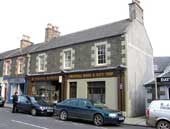Innerleithen
Innerleithen is on the confluence of Leith water and Tweed. The area has been inhabited since pre-Roman times. The town is said to have been founded by an itinerant pilgrim monk called St Ronan in A.D.737, who came to Innerleithen via the River Tweed in a coracle.
A carved Celtic stone of considerable antiquity (known as the Runic Cross) has been found on the slopes of the Leithen valley suggesting that a church existed during the early Middle Ages. The stone can be seen in the courtyard of the parish church on Leithen Road.
Original for Sir Walter Scott’s “St Ronan’s Well” It used to be a spa town and the “St Ronan’s Well” interpretive centre at Wells Brae explains the history of the well whose waters are full of sulphur and other minerals.
Although the Spa itself was built in 1827 by Earl of Traquair it was widely used before that time. The Victorians used the mineral water for its renowned curative effects. It underwent extensive refurbishment in 1896 to provide an indoor bathing area as well as bottling plant.
 In the high street is Robert Smail’s printing works (NTS). This was a genuine print works that has maintained many of its original features and fittings when taken over by the trust in 1987.
In the high street is Robert Smail’s printing works (NTS). This was a genuine print works that has maintained many of its original features and fittings when taken over by the trust in 1987.
The technology dates back to 1893 and includes a reconstruction of the waterwheel that once powered the printing press. It shows how nespapers were produced up until 1916.
At one point Innerleithen had five significant wool mills and its population rose from 1130 (in 1861) to its current level of over 2500. Of these, only two remain, and these survive by producing high quality fashion knitwear and cashmere for international markets.

